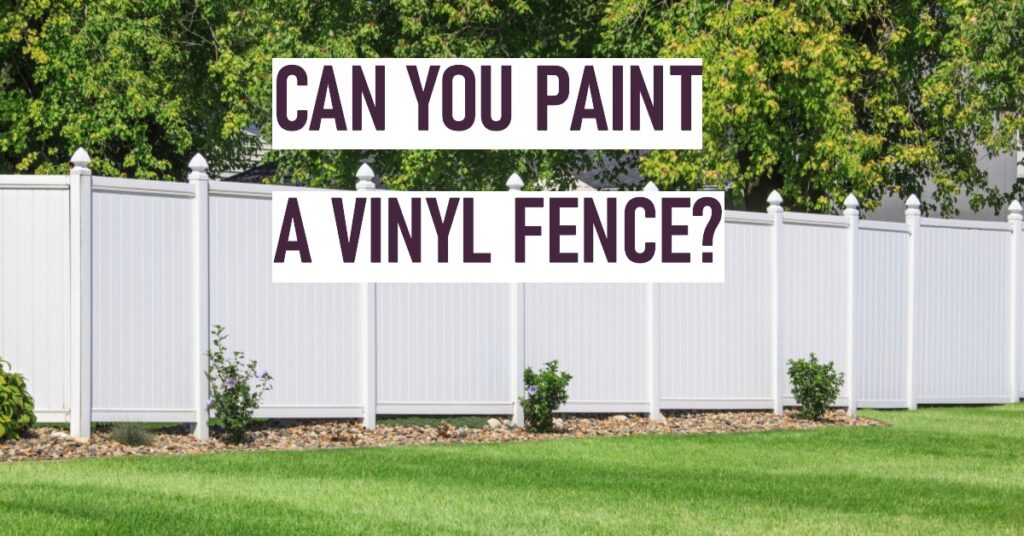Have you ever looked at your vinyl fence and wondered if you could give it a fresh new look? “Can you paint a vinyl fence?” may be the question lingering in your mind. If so, this blog post is for you! Vinyl fences have gained popularity due to their low maintenance and long-lasting nature; however, painting them can be trickier than other fencing materials.
In this article, we’ll explore the challenges of painting vinyl fences, how to properly prepare the surface, choose the right type of paint and primer, as well as alternatives to consider if painting isn’t ideal for your specific situation.
Can You Paint A Vinyl Fence?
Discover the non-porous nature of vinyl and whether it is possible to paint a vinyl fence, considering factors such as adhesion of paint to vinyl, type of paint and primer required, and guidelines for preparing the surface before painting.
Understanding The Non-Porous Nature Of Vinyl
One critical aspect that sets vinyl apart from other fencing materials is its non-porous nature. This means that the surface of a vinyl fence has minimal to no tiny spaces, making it more resistant to water penetration and stains.
The non-porous surface of vinyl makes paint adhesion difficult because there are no pores for the paint to grip onto. As most traditional paints are designed for porous surfaces like wood, applying them on a vinyl fence often leads to unsatisfactory results since they tend not to bond well with the material.
If you still wish to change or touch up your existing white or black PVC fence, it’s essential to choose specialized epoxy-based paints formulated specifically for non-porous materials such as PVC (vinyl).
Factors To Consider Before Painting
Before attempting to paint a vinyl fence, several factors must be taken into consideration. Firstly, it is important to note that painting a vinyl fence can be challenging because of the non-porous nature of the material.
Another factor to consider is the climate in your area. Extremely hot or cold temperatures can affect how well paint adheres to a vinyl fence, so it’s best to choose an optimal time for painting when temperatures are moderate.
Choosing the correct type of paint and primer is also essential for ensuring adhesion and durability. Epoxy-based paints are recommended for use on vinyl fences as they have excellent adhesive properties and provide long-lasting protection against weathering and fading.
Choosing The Right Paint And Primer
When it comes to painting a vinyl fence, choosing the right paint and primer is crucial. As mentioned earlier, most paint won’t stick to a non-porous material like vinyl, so it’s important to choose a specialized epoxy-based paint that is designed specifically for use on vinyl surfaces.
Additionally, using the correct primer is crucial in ensuring that the paint adheres properly without peeling or flaking off over time. Look for a primer that is specially formulated for use on vinyl surfaces and follow its application instructions carefully.
Choosing high-quality paints and primers will help ensure proper adhesionwhich makes all the difference when it comes to achieving long-lasting results while also reducing costly maintenance efforts down the line – saving homeowners time and money in the process.
Preparing The Vinyl Fence For Painting
Before painting a vinyl fence, it is important to thoroughly clean and dry the surface, as well as sand it lightly to help the paint adhere better.
Cleaning And Drying The Surface
Before painting a vinyl fence, it’s important to clean and dry the surface properly. Dirt, grime, and other contaminants can prevent paint from adhering well to the fence.
Begin by using a solution of water and mild soap, along with a soft-bristled brush or sponge to scrub the fence.
If there is mold or mildew on the vinyl fence, use a solution of bleach and water (1 part bleach to 3 parts water) instead.
Sandpaper may be used to sand any rough spots or scratches on your vinyl fence after cleaning in preparation for that smooth finish you desire when finished painting. By following these steps carefully during the cleaning process, you create an optimal surface upon which paint can adhere correctly resulting in an improved appearance of your fence.
Sanding The Fence
Before painting a vinyl fence, it is essential to sand the surface properly. Sanding helps create small scratches on the vinyl’s smooth surface, allowing paint and primer to bond better with the material.
Use fine-grit sandpaper like 220 grit or higher and avoid using coarse grits that can damage the surface of your fence.
Once you’re finished sanding, use a clean cloth or brush to remove any debris left over from sanding before applying primer or paint. Sanding may seem like an unnecessary step when painting a non-porous material like vinyl, but it is crucial for getting good results with your fence painting project.
Steps For Painting A Vinyl Fence
To paint a vinyl fence, you need to apply the primer and the paint properly, which can be challenging due to the non-porous nature of vinyl; read on to discover some useful tips for achieving the best results!
Applying The Primer
Before painting your vinyl fence, it is important to apply a high-quality primer specifically designed for use on nonporous surfaces like vinyl. Look for an epoxy-based paint and primer that offers excellent adhesion to ensure the best results.
To start priming your vinyl fence, first, make sure the surface is clean and dry. Then, using a brush or roller, apply a thin coat of primer in even strokes over small sections of the fence at a time.
Allow each section to dry completely before moving on to prevent drips and bubbles from forming.
Applying The Paint
Once the vinyl fence has been primed and allowed to dry, it’s time to apply the paint. When applying paint, make sure that you’re using an epoxy-based paint that is designed for use on vinyl surfaces.
Using a high-quality brush or roller will ensure maximum coverage without leaving streaks or drips on the surface.
One thing to note when painting a white vinyl fence is that light colors can fade quickly in sunlight, especially in warm climates. To prevent this from happening, consider using light-reflecting pigments in your chosen color or choosing darker shades.
Additionally, if you’re looking for a quick solution to changing the color of your vinyl fence without painting it black or white, consider using a decorative wrap or sticker instead.
Tips For Achieving The Best Results
To achieve the best results when painting a vinyl fence, it’s important to follow some key tips. First and foremost, make sure you clean and dry the surface of the fence thoroughly before painting.
Next, choose an epoxy-based paint specifically designed for use on vinyl surfaces.
When applying the primer and paint, be sure to use even strokes in one direction to create a smooth finish.
Finally, keep in mind that climate can play a role in your painting success. Avoid painting on very hot or humid days as this can cause the paint to dry too quickly or not adhere properly.
Alternatives To Painting A Vinyl Fence
In addition to painting, there are other options available if you want to change the look of your vinyl fence. Vinyl fence wraps and stickers offer a quick and easy solution for changing up the appearance of your fence without having to deal with the challenges of painting.
Vinyl Fence Wraps
Another alternative to painting a vinyl fence is using vinyl fence wraps. These are essentially large sheets of durable, weather-resistant material that can be applied directly onto the surface of the fence.
Vinyl fence wraps also offer additional benefits such as protection from UV rays and resistance to harsh outdoor elements like wind and rain. They are easy to install, requiring only basic tools and some adhesive material.
Vinyl Fence Stickers
Another alternative to painting a vinyl fence is using vinyl fence stickers. These are essentially large decals that adhere to the surface of the vinyl fence, allowing homeowners to easily change the appearance of their fencing without having to go through the complicated and time-consuming process of painting it.
While this option may be more convenient than painting, it’s important to note that vinyl fence stickers may not last as long as paint or wraps. They can also be more difficult to remove and replace if you want to change your fence’s look again in the future.
Benefits And Drawbacks Of Each Option
While painting a vinyl fence can be a complicated process, it is not the only option for updating its appearance. Vinyl fence wraps are one alternative that homeowners may consider.
These wraps can be applied directly to the existing fence, providing a new color or design without the need for sanding or priming.
Another alternative to painting a vinyl fence is using vinyl fence stickers. These stickers feature various designs and patterns that adhere directly to the surface of the vinyl fencing.
Overall, while there are alternatives to painting a vinyl fence such as wraps or stickers, each option has its benefits and drawbacks that should be carefully considered before making any decisions on which method to use for updating your home’s exterior look.
Conclusion
In conclusion, while it is possible to paint a vinyl fence, it requires careful consideration and attention to detail. Due to the non-porous nature of vinyl, finding the right paint and primer that will adhere well to the surface is crucial.
Proper preparation of the fence before painting is also essential for achieving the best results. Alternatives such as wrapping or using stickers on your vinyl fence are worth considering if you’re looking to change up its appearance without undergoing a complicated process.









